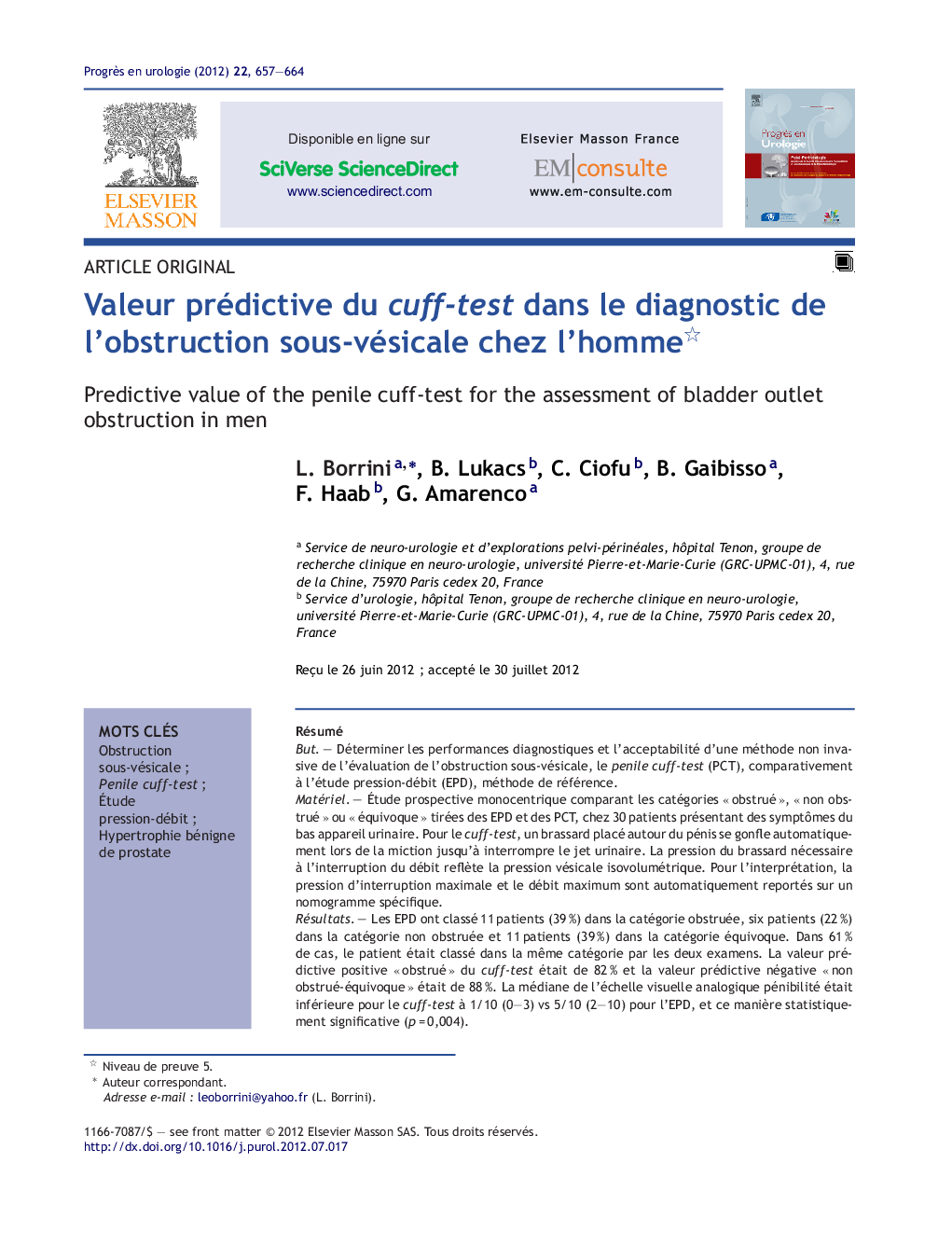| Article ID | Journal | Published Year | Pages | File Type |
|---|---|---|---|---|
| 3825056 | Progrès en Urologie | 2012 | 8 Pages |
RésuméButDéterminer les performances diagnostiques et l’acceptabilité d’une méthode non invasive de l’évaluation de l’obstruction sous-vésicale, le penile cuff-test (PCT), comparativement à l’étude pression-débit (EPD), méthode de référence.MatérielÉtude prospective monocentrique comparant les catégories « obstrué », « non obstrué » ou « équivoque » tirées des EPD et des PCT, chez 30 patients présentant des symptômes du bas appareil urinaire. Pour le cuff-test, un brassard placé autour du pénis se gonfle automatiquement lors de la miction jusqu’à interrompre le jet urinaire. La pression du brassard nécessaire à l’interruption du débit reflète la pression vésicale isovolumétrique. Pour l’interprétation, la pression d’interruption maximale et le débit maximum sont automatiquement reportés sur un nomogramme spécifique.RésultatsLes EPD ont classé 11 patients (39 %) dans la catégorie obstruée, six patients (22 %) dans la catégorie non obstruée et 11 patients (39 %) dans la catégorie équivoque. Dans 61 % de cas, le patient était classé dans la même catégorie par les deux examens. La valeur prédictive positive « obstrué » du cuff-test était de 82 % et la valeur prédictive négative « non obstrué-équivoque » était de 88 %. La médiane de l’échelle visuelle analogique pénibilité était inférieure pour le cuff-test à 1/10 (0–3) vs 5/10 (2–10) pour l’EPD, et ce manière statistiquement significative (p = 0,004).ConclusionLe cuff-test apparaissait être une technique alternative crédible à l’étude pression débit formelle. Ses valeurs prédictives étaient bonnes et sa tolérance meilleure.
SummaryPurposeTo assess the diagnostic performances and the acceptability of the penile cuff test (PCT) which is a non invasive method for the evaluation of bladder outlet obstruction (BOO), in comparison with the pressure flow study (PFS), the actual gold-standard.MaterialMonocentric prospective study comparing the following subsets: “obstructed”, “not obstructed” or “equivocal”, deduced from PFS vs PCT, in 30 consecutive patients presenting with lower urinary tract symptoms. For the PCT, a cuff placed around the penis inflated automatically during the micturition, until flow rate interruption. The interruption cuff pressure revealed the isovolumetric bladder pressure (Pcuff-int). The data collected – Pcuff-int and maximum flow rate – were automatically reported on ICS modified nomogram.ResultsWith the PFS, 11 patients (39%) were classified “obstructed”, six patients (22%) “non-obstructed” and 11 patients (39%) “equivocal”. In 61% cases, the patient was classified in the same category by both techniques. The “obstructed positive predictive value” of the PCT was 82% and the “non-obstructed-equivocal negative predictive value” was 88%. The median acceptability visual analogic scale score was 1/10 (0–3) for the PCT whereas it was 5/10 (2–10) for the PFS. This difference was statistically significant (p = 0.004).ConclusionThe PCT was a reliable non-invasive tool for the diagnosis of BOO in male, in comparison with PFS. The predictive values of the PCT were relevant and its tolerance was better than PFS.
